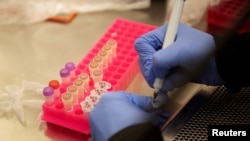In the race for a vaccine to end the global COVID-19 pandemic, eight contenders are at the front of the pack.
These eight vaccine candidates are undergoing human testing in clinics in China, the United States, Britain and Germany. Behind them are at least 94 others in various stages of development.
The Trump administration is pushing to have hundreds of millions of doses of a vaccine available by the end of the year. However, experts say the unprecedented speed risks taking shortcuts on safety, and there's no guarantee that any of the vaccine candidates will work.
"It worries me, actually, that we aren't going to know key issues about safety and effectiveness if we're planning on rolling it out that quickly," said Paul Offit, director of the Vaccine Education Center at Children's Hospital of Philadelphia.
Three ways
The eight vaccine candidates fall into three categories.
One category might be called the classical technique: triggering the patient's immune system to respond to the virus by injecting a killed version of it. Three separate groups of Chinese researchers are testing inactivated-virus vaccines.
A second method uses one virus to fight another.
Whether it causes COVID-19, Ebola disease or the common cold, a virus is basically just an envelope containing instructions to make more of the virus.
In this novel vaccine strategy, scientists strip out instructions from one virus and replace them with instructions to make just a piece of the coronavirus.
A shot of the modified virus does not cause illness. The virus infects some of the patient's cells, but instead of copies of infectious virus, those cells produce the piece of coronavirus. The patient's immune system responds to the coronavirus protein so it can fight off the invader later.
Two separate groups from China and Britain are pursuing this approach.
A third novel strategy cuts out the middleman. Rather than delivering instructions in a virus, researchers inject genetic code for a piece of the coronavirus directly into the patient in the form of DNA or RNA.
Two groups are working on RNA vaccines, and one on a DNA shot.
The newer methods are fast and flexible, according to Kimberly Taylor, head of the biodefense vaccine development section at the National Institute of Allergy and Infectious Diseases.
"They are very good for pandemic platforms because they're typically plug-and-play — very quick manufacturing, very quick to get into the clinic," she said.
Pros and cons
Each technique has pros and cons.
"We're not going to put all our eggs in one basket," said Emory University Vaccine Center Associate Director Walter Orenstein. "Different groups are looking to see what will work and what might not work."
The killed-virus system is the most tried-and-true. But killing the virus can change its shape. The immune system might respond to the killed virus differently than the real thing.
Viral vectors are a new strategy, and it's not clear how well different carrier viruses will work. In some cases, people may have already been exposed to the carrier virus, which would reduce its effectiveness.
DNA vaccines require special equipment.
"It's not as simple as just using a needle and syringe. You have to have this whole other device," Taylor said.
And an RNA vaccine would need some additive to keep the active ingredient from breaking down.
'You never know'
Experts are concerned that the extremely compressed timeline will not allow for definitive answers on whether a vaccine is safe and effective.
Developing a vaccine typically takes around 20 years. It's usually tested in tens of thousands of people before it's approved for wider distribution, because safety issues may not be immediately obvious.
For example, in a clinical trial of 35,000 patients, researchers discovered that a dengue vaccine did more harm than good for children under 9 years old who had not had a case of dengue before receiving the vaccine. They developed more serious cases of dengue than those who had not been vaccinated before their first dengue infection.
"You never know until you put things into large numbers of people," Offit said. "Then and only then do you find out what the story is."
People may lower their standards for a coronavirus vaccine, however.
"Because people are reasonably panicked by this virus, I think they're willing to accept a certain level of risk that they wouldn't normally accept," Offit added.
Since speed is of the utmost importance, manufacturers need to ramp up production before they know if their vaccine works.
"If you're a manufacturer, what is your willingness to manufacture loads and loads of doses if it turns out your vaccine fails?" Orenstein asked.
"And how would we cushion the risk? Should there be a fund to say, 'If you develop that vaccine, we'll buy as many doses even if we have to flush them down the toilet because the vaccine didn't work or was unsafe?'"
The U.S. government has signed deals with two vaccine companies totaling nearly $1 billion that include scaling up production.
Vaccine test results are still several months away for all the candidates.












